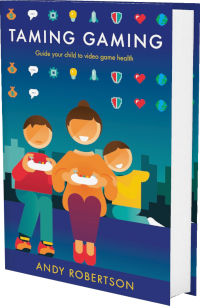 Android
Android iOS
iOS Mac
Mac Switch
Switch Wii
Wii Wii U
Wii U PC
PC PS4
PS4 PS5
PS5 Xbox One
Xbox One Xbox X|S
Xbox X|SWe've documented 45 accessibility features for I Was a Teenage Exocolonist, including Large Text, Guaranteed Progress, Low Pressure, No Quick Reactions and Select Difficulty. Its accessibility is strongest in Controls and Getting Started but it also has features in Visual, Reading, Navigation, Difficulty and Audio to reduce unintended barriers.
This report is created with input from accessibility experts and the player community to help people find games that have the accessibility features they require. Once you have found potential games on the database, there are excellent specialist accessibility sites that offer in-depth reviews to guide your purchasing decisions.
External examiner, Sarah Northway, first checked I Was a Teenage Exocolonist accessibility 7 months ago. It was re-examined by Andy Robertson and updated 7 months ago.
 Game Details
Game Details
Release Date: 25/08/2022
Out Now: PC, PS4, Switch and Xbox One
Skill Rating: 10+ year-olds
Players: 1
Genres: Communication, Narrative (Adventure, Battle, Collecting, Puzzle and Sequencing)
Accessibility: 45 features
Components: 2D Side-On, Cards and Cartoon
Developer: Northway Games (@NorthwayGames)
Costs: Purchase cost
 Controls
Controls
We've documented 17 accessibility features for Controls in I Was a Teenage Exocolonist which deal with how you control the game, different options for alternative inputs and whether you can remap these settings to suit your needs.
Gamepad
Can play with the following:
Multiple Buttons & Single Stick: Can play with multiple buttons and a stick.
Multiple Buttons & Two Sticks: Can play with multiple buttons and two sticks.
Mouse And Keyboard
Can play with the following:
Keyboard Alone: Can play with just the keyboard.
Mouse Alone: Can play with just the mouse/mouse-button/mouse wheel.
Mouse and Keys: Can play with mouse and multiple keys.
Mouse and Controller: Can play with mouse and controller simultaneously.
Touchscreen
Can play with the following. Additional gestures may be required for games played with a screenreader like VoiceOver.
One Tap Targeted: Can play with touchscreen, tap in specific locations.
Remap Controls
Can customise the controls for the game as follows:
Remap Buttons: Can re-map all buttons so that you can use alternatives that better suit your play.
Swap Sticks: Can swap the sticks over so that you can use the opposite sticks to control the game.
Remap Sticks: Can remap the stick controls to controller buttons for easier access of direction controls.
Remap Mouse and Keyboard: Can remap mouse and keyboard key bindings, on systems that support these controls.
Remap One Action to Multiple Buttons: Can remap multiple buttons to perform the same action to reduce the need to memorise buttons and make the action easier to access.
Remap Game Menu Access: Can remap buttons to pause, access and navigate the game menu. This enables you to specify which buttons pop-up the game menu.Whether you can remap menu navigation buttons isn't considered here.
Button Combinations
Specific button operation required to play
Holding Down Buttons Optional: Holding down buttons for prolonged periods (a second or more) is not required or can be switched to toggling the action on and off. This is in addition to the movement stick/button which is not considered a hold for this purpose.
Rapid Repeated Pressing Optional: Quick, repeated button pressing (more than 2 times a second) is not required, can be skipped or switched to holding a button to trigger a repeated action.
No Simultaneous Buttons: Only one button or key required at a time, in addition to direction stick(s).
Controller Vibration
Vibration Optional: Controller vibration not used in the game or you can disable it.
 Difficulty
Difficulty
We've documented 2 accessibility features for Difficulty in I Was a Teenage Exocolonist which deal with how you can adjust the challenge of play, and whether this is locked once chosen or can be adjusted as you play.
Difficulty Options
Select Difficulty: Select the level of difficulty from a range of presets. This not only offers a way to adjust the challenge of a game but enables you to do so without dealing with individual criteria.
Adjust After Setting
Adjustable Anytime: You can adjust the difficulty while playing, without having to restart the level you are on. This enables you to quickly adjust the game to suit your needs and see the difference immediately.
Similar Games With More Accessibility Features for Difficulty
If you want to play I Was a Teenage Exocolonist, but it doesn't offer the Difficulty accessibility features you require, this similar game extends the Difficulty accessibility:
- Wildermyth (3 Difficulty Features)
 Getting Started
Getting Started
We've documented 9 accessibility features for Getting Started in I Was a Teenage Exocolonist which deal with what support is offered to get started with the game. This includes customising the experience when you first open the game via any onboarding processes it provides as well as tutorials and other assistance when you first start playing.
Assistance Getting Starting
These features aid your play of the game in terms of cognitive load on learning controls, dealing with pressure and coping with the environment and challenges.
Tutorials: There are helpful tutorials and instructions on how to play. Information is provided in a timely manner, with appropriate level of detail.
View Control Mapping: You can view a map of controls during play. This clearly displays the mappings of actions to buttons/keys/mouse/keyboard without having to leave the game. This includes games that always display buttons to press during play.
Reaction-Time Not Critical: Individual game actions don’t need quick reactions, or there are settings to lower the requirement for quick reactions. This means you don't need to quickly press a button in response to an on-screen prompt, target a fast-moving target or skillfully complete a scenario against the clock.
Low Pressure: Game tasks aren't time-limited or there's a low-pressure mode. This avoids the pressure of being put on the clock for overarching missions, or failing tasks because you didn't reach a destination in time.
No Jump Scares: No sudden loud noises or popping-up scary visuals that unexpectedly appear without warning, or the option to disable them.
Assistance For Progressing
These features aid your progress through the game offering different ways of maintaining your progression.
Guaranteed Progress With God Mode: There is no fail state for any game level, where you lose progress or have to start again. Or there are options to make failing impossible: infinite health or lives, unlimited time. Sometimes called God Mode or Unfailable.
Assisted Recall for Characters: The game provides reminders about character identity during play. This includes pop-up images and bios for character who is speaking.
Assisted Recall for Narrative and Dialogue: The game enables you to review the history of conversations or provides highlights of the information you gather in a form you can review.
Save Progress Anytime: The game automatically saves progress or you can save any time. This doesn’t mean you never lose progress, but it does mean you can stop whenever you want (without having to get to a save point) without losing progress.
 Reading
Reading
We've documented 5 accessibility features for Reading in I Was a Teenage Exocolonist which deal with how much reading or listening comprehension is required, how well the game provides visual and audible access to the text and whether subtitles and captions are a good fit for purpose.
Reading Level
How much reading is required to play the game's main path or story and how complex the language is. The presence of voiced characters doesn't reduce this requirement, as it's recorded as a separate datapoint.
Extensive Complex Reading: Extensive reading required. The quantity and complexity of reading is suitable for someone who loves long books and enjoys extended dialogue or narrative descriptions.
Text Visibility
Large Clear Text: All essential text is large and clear or can be adjusted to be. The general text used throughout the game in menus, instructions and other key information (excluding subtitles that are assessed separately) is at least 1/20 (46 pixels on 1080 screen) the height on landscape screens and at least 1/40 height on portrait screens. We base this on the full line-height, including the space above and below the letters.
High Contrast Text: Text colour contrasts to the background or can be adjusted to be. The text in menus, instructions and other information is presented in high contrast with a solid background.
Subtitles
All Speech Subtitled (Or No Speech In Game): All spoken content has subtitles, or there is no speech in the game. This means there is no requirement to hear spoken dialogue or narrative to play the game.
Captions
Speaker Indicator and their Tone: Textual captions indicate who is speaking and their tone (or there is only ever one person speaking). This can also be indicated visually in the game with character icons or character expressions with text in speech bubbles next to the person speaking.
Similar Games With More Accessibility Features for Reading
If you want to play I Was a Teenage Exocolonist, but it doesn't offer the Reading accessibility features you require, these similar games extend the Reading accessibility:
- Monorail Stories (7 Reading Features)
- Wayward Strand (7 Reading Features)
- Heaven's Vault (7 Reading Features)
- Iris and the Giant (6 Reading Features)
 Navigation
Navigation
We've documented 4 accessibility features for Navigation in I Was a Teenage Exocolonist which deal with how the game provides guidance and assistance to navigate its worlds. These are only for games that have traversal and exploration in 2D and 3D spaces.
Menu Navigation
Menu Audio Cues: Navigating menus provide an audio cue for each selection.
Digital Menu Navigation: Menu choices with Gamepad can be made without using an analogue stick to guide a cursor to a selection. For example, using D-Pad, buttons or the Stick to change menu selection in a single action.
Menus Don't Wrap: Menus don't wrap and stop the cursor at the bottom of the list if you press down. Or menus do wrap but make it clear that you are back at the top of the list with sound or narration.
Remap Game Menu Access: Can remap buttons to pause, access and navigate the game menu. This enables you to specify which buttons pop-up the game menu.Whether you can remap menu navigation buttons isn't considered here.
Similar Games With More Accessibility Features for Navigation
If you want to play I Was a Teenage Exocolonist, but it doesn't offer the Navigation accessibility features you require, these similar games extend the Navigation accessibility:
- Roguebook (7 Navigation Features)
- Monorail Stories (5 Navigation Features)
- Wildermyth (5 Navigation Features)
- Penko Park (5 Navigation Features)
 Visual
Visual
We've documented 8 accessibility features for Visual in I Was a Teenage Exocolonist which deal with how you can adjust the visuals to suit your needs, and offer additional information if you can't hear the game.
Contrast
Medium Contrast: Game uses generally well contrasting and bright visuals, or has a slider to make this the case.
Interactive Elements
Large Game Elements: Game characters and other elements are large and distinguishable. Enemies and player characters are at least 1/6 of the height of the screen. Or there is a zoom feature to make them larger.
Outline Interactive Elements: Characters, platforms and enemies can be outlined or highlighted for visibility. This can be with a large border around the character or a special visual mode that adjust the colour to make characters more visible.
Visual Distractions
No Flashes: No flashing strobe effects or you can disable them. This includes the absence of flashing from dramatic visual effects, explosions or weather effects like lightning.
No Screen Shake: No screen shake effect or it is included but it can be disabled. This includes the absence of screen shake for dramatic effect as well as to indicate hits on a target.
Audio Cues for Visual Events
Menu Audio Cues: Navigating menus provide an audio cue for each selection.
Motion Sickness Friendly
Motion Sickness Friendly: Doesn't have 3D movement elements that may trigger motion sickness, like motion blur, depth of field and field-of-vision. Or includes the ability to disable motion blur, depth of field and field-of-vision effects.
Colour Options
Colour Blind Friendly: Game doesn’t rely on colour or can switch to colour blind friendly mode with double coding or similar way to avoid colour dependance.
Similar Games With More Accessibility Features for Visual
If you want to play I Was a Teenage Exocolonist, but it doesn't offer the Visual accessibility features you require, these similar games extend the Visual accessibility:
- Iris and the Giant (9 Visual Features)
- Neurodeck (9 Visual Features)
 Audio
Audio
We've documented 2 accessibility features for Audio in I Was a Teenage Exocolonist which deal with how you can adjust the audio of the game and whether audio cues compensate for aspects of the game that are hard to see.
Adjustable Audio
Balance Audio Levels: Set music and game sound effects separately. This enables you to select your preference as well as ensure critical game sounds aren't obscured by other audio.
Play Without Hearing
Play Without Hearing: No audio cues are necessary to play the game well.
Similar Games With More Accessibility Features for Audio
If you want to play I Was a Teenage Exocolonist, but it doesn't offer the Audio accessibility features you require, these similar games extend the Audio accessibility:
- Videoverse (3 Audio Features)
- Wildermyth (3 Audio Features)
- Alba: A Wildlife Adventure (3 Audio Features)
System Accessibility Settings
In addition to the accessibility features provided in the game, you can also use system-wide accessibility settings:
Nintendo Switch
Nintendo Switch has some built-in features, including a lockable zoom, that can be used on all games.
PC
Windows has extensive accessibility features. Some, like colour correction, work with games. Lots of accessibility software can be used with PC games, from voice recognition to input device emulators.
PlayStation 4
PlayStation 4 has a range of accessibility settings. Some are system only, some work in games (invert colours and button mapping).
Xbox One
Xbox One has a system features, the excellent co-pilot share controls mode and adaptive controller support for all games.
Read more about system accessibility settings.
Accessibility Report supported by VSC Rating Board, PlayabilityInitiative and accessibility contributors Andy Robertson












